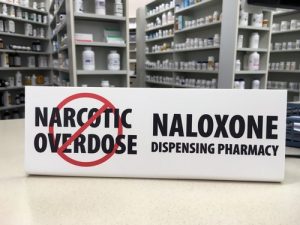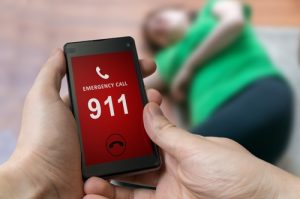Narcan (Naloxone)
While overdose deaths involving opioids are lower in Texas than in many other states, opioid overdose is still a major problem in the state. In fact, the abuse of opioids is the leading driver of overdose deaths in Texas.1
Naloxone, the opioid overdose reversal drug, has become a critical resource in preventing overdose deaths in Texas and across the nation. Naloxone comes in a nasal spray (Narcan, Rivive, and Kloxxado are brand names of naloxone). Naloxone nasal spray is easy for people to administer with minimal instruction.2
This article will provide information on how to find naloxone in Dallas and the greater state of Texas, provide basic information on naloxone and its use, and discuss the problem of opioid overdose in Texas.
How Does Narcan Work?

Naloxone is a medication designed to bind to opioid receptors and block the effects of opioids. In doing so, it effectively reverses an opioid overdose.2
Someone whose breathing has slowed or stopped may experience a quick return to normal respiration once given the drug.2
Naloxone carries no addiction or misuse potential and can be delivered by a layperson in an emergency situation.2
What Is Narcan Used For?
Prior to 2015, naloxone was administered by emergency services personnel and other health professionals; however, in most states, including Texas, there has been an effort to expand access to this medication to those who are likely to witness an opioid overdose. This includes opioid users and their friends and families, as well as the general public.2
Learn How to Use Narcan with Our Training Video
Narcan Side Effects
In one clinical study on Narcan nasal spray, the following adverse reactions were observed:3
- Nasal dryness.
- Nasal congestion and inflammation.
- Increased blood pressure.
- Headache.
- Muscle and bone aches.
Because naloxone blocks opioids from binding to receptors, it can cause someone to enter precipitated withdrawal if they are physiologically dependent on opioids. This precipitated withdrawal may be uncomfortable, but the reversal of opioid-induced respiratory depression can be lifesaving.4
Where Can You Get Narcan?
Naloxone nasal spray is available in many locations and through various programs throughout Texas. Some of these include:
- Naloxoneexchange.com: This website provides instructions on administering naloxone and provides a way to buy the medication online and have it delivered to your door. The site offers brand-name Narcan nasal spray as well as generic naloxone kits with vials, a syringe, and an atomizer.
- Texas Walgreens and other TX pharmacies: More than 700 Walgreens stores in Texas allow you to purchase generic naloxone over the counter without a prescription to keep on hand in the event of an emergency.3 You can also find naloxone at TX CVS stores, as well as at Krogers and Walmart stores.4,5,6
- MoreNarcanPlease.com: This website offers Texans both a way to order Narcan online and also offers training materials, including videos, on steps to take in an overdose emergency.
- Texas Harm Reduction Alliance (THRA): Based in Austin, this organization provides mobile and street-based overdose prevention resources, as well as a drop-in center. THRA provides Narcan to drug users, along with other services including testing for Hepatitis C.
- Greenhouse Treatment Center: Our center has provided free naloxone training events to the community on how to administer Narcan in the past. See if any new training events are happening soon.
Does Texas Have a Good Samaritan Overdose Immunity Law?
A Texas Good Samaritan Law offers some legal protections for those who administer naloxone nasal spray in good faith and with reasonable care.6
Section 483.106 of the Health and Safety Code states that any person who acts “in good faith and with reasonable care” who administers naloxone doses to someone they believe is suffering from an opioid-related overdose is protected from “criminal prosecution, sanction under any professional licensing statute, or civil liability, for an act or omission resulting from the administration of or failure to administer the opioid antagonist.”8
There is also a Texas Good Samaritan Law that provides protection from civil damages for acts performed in an emergency that were made in a good faith attempt to help another person.9
Unfortunately, currently the laws in Texas address only liability regarding the medical outcomes relating to a person’s action (or inaction) in an emergency. They do not provide basic protections from drug offenses, such as possession of a controlled substance, for those who call 911 and/or administer naloxone in an emergency overdose situation. However, there have been repeated efforts to expand the protections and expand the Good Samaritan Law in the state.9,10
How to Respond to an Opioid Overdose

Step 1: Call for Emergency Help
The very first thing to do when you believe someone is overdosing is to CALL 911. While on the phone with 911, give your location and a description of it to help responders find you quickly.11
The person who has overdosed always requires emergency medical support after their overdose has been reversed. A person may continue to experience overdose effects after the naloxone wears off, or a person may require multiple doses of naloxone. This is why it is so important that you call 911 prior to administering the drug.2
Step 2: Give Naloxone
After calling 911, you can move on to delivering naloxone if you have it on hand. To administer naloxone in an overdose emergency, follow the instructions on the box/packaging.2
Many Texas organizations offer classes on how to administer naloxone to empower you to feel in control and calm in an overdose emergency.
Step 3: Stay with the Person Until Help Arrives
Once you’ve administered naloxone, stay with the person and lay them on their side with their knees bent to make sure they don’t choke should they begin to vomit.
If you are trained in CPR, you may provide rescue breathing at this time.11 The Red Cross offers a list of CPR training classes in Dallas.
Opioid Overdoses in Texas
Texas, like every other state in the nation, has struggled with the epidemic of opioid abuse and overdose.1
Texas has had consistently “low” rates of opioid overdose compared other states; however, the Lone Star State is far from untouched by the crisis.

Texas has had consistently “low” rates of opioid overdose compared to other states; however, the Lone Star State is far from untouched by the crisis. Consider that:13-15
- Drug overdose deaths increased by more than 10.6% between February 2021 and February 2022.
- In TX, between 2015 and 2022, reported overdose deaths rose from 2,577 to 4,820.
- Opioids are the main driver of drug overdoses in Texas, with more than half of all overdose deaths resulting from opioids.
- Opioid overdoses have become a leading cause of maternal death for mothers in Texas.
- In 2021 in Texas, nearly 1,700 people died as a result of a fentanyl-involved overdose.
The Growing Presence of Fentanyl in Texas
Fentanyl is a notorious contributor to the opioid epidemic across the United States. The presence of fentanyl in the drug market in the Western United States, including Texas and Arizona, is growing and is projected to cause more deadly overdoses in states west of the Mississippi in the coming years.14
However, it is not just heroin that Texans need to worry about. Fentanyl has been found in multiple other drugs including:16
- Counterfeit pain pills.
- Counterfeit depressants such as Xanax.
- Stimulants, such as cocaine, meth, and amphetamines.
Opioid abuse, even when fentanyl is not a factor, is associated with a high risk of overdose. However, with the proliferation of fentanyl across the United States, the risk of overdose is much greater for those who purchase and use drugs illicitly. If you use opioids or know someone who does, having naloxone on hand and knowing how to use it can be lifesaving.
Are you ready to seek help and start the addiction treatment process? If you or someone you love is struggling with addiction and are ready to take the first steps toward recovery, call us today at . Greenhouse Treatment Center, American Addiction Centers’ Texas drug rehab center, is ready to help you get the treatment you need today.
Admissions navigators can also answer questions about using insurance to pay for addiction treatment, other ways to pay for rehab, and what to expect in addiction treatment. You can also verify your insurance coverage by completing the confidential online form.